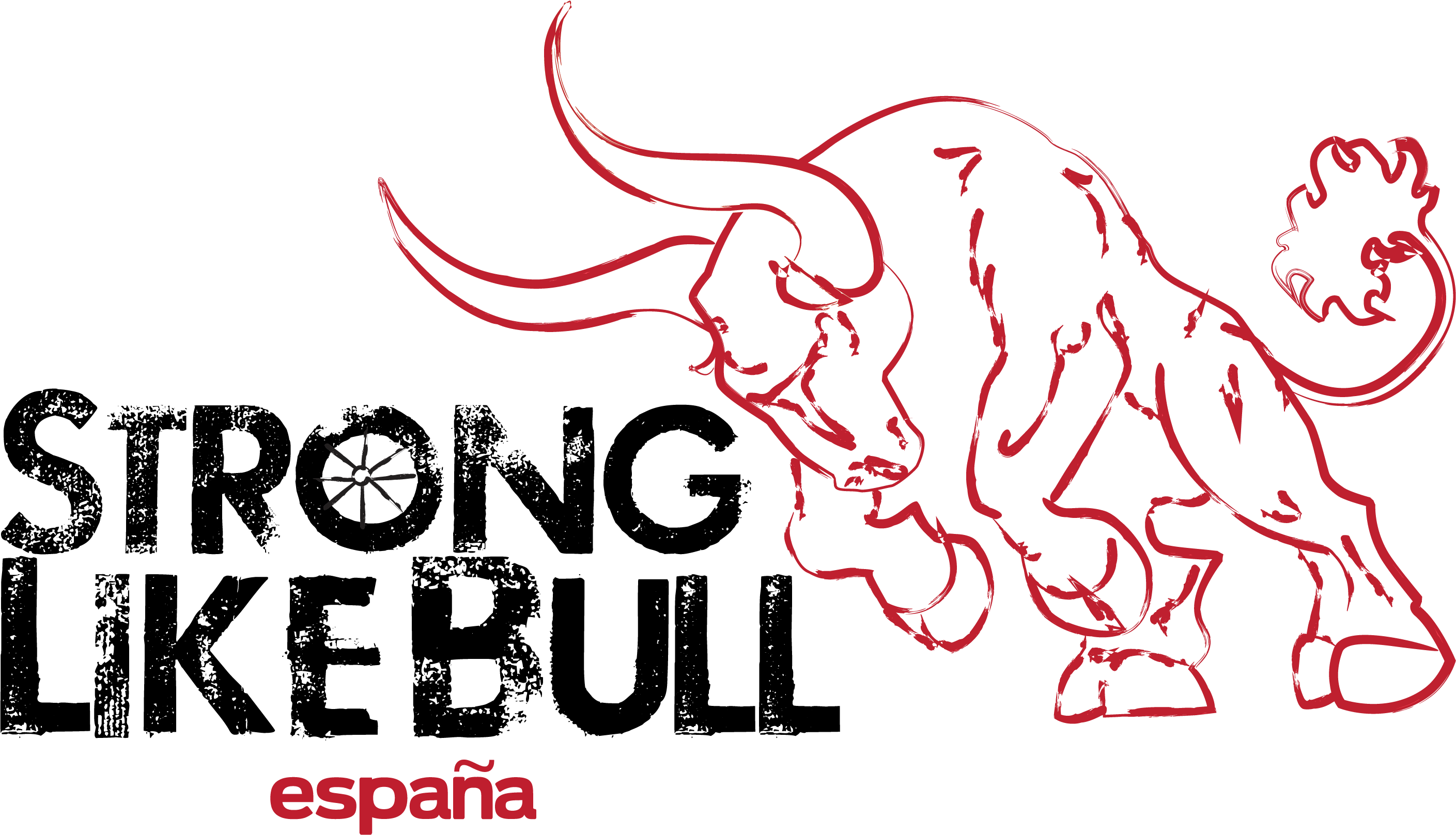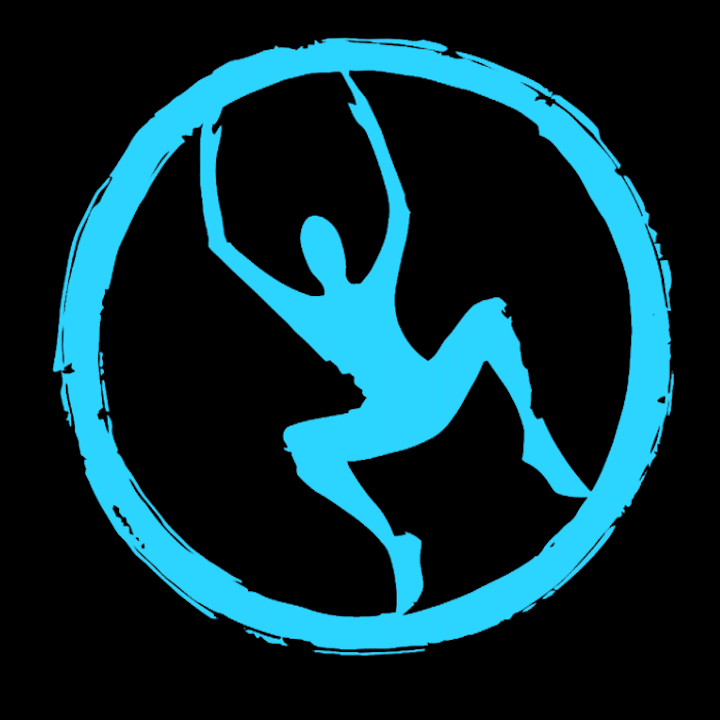Brick
Our virtual brick workouts are written by our Thursday Morning Brick Coach, Coach John Stewart! Learn more about Coach John here.
BTC Brick Workout – Week 15 – July 16, 2020
BTC Brick Workout
Week 15
7/16/20
Hi Everyone,
If you are doing the race this weekend, here is your race-prep brick:
Notes for the race: Make sure to measure everything! Heart Rate, Power, Cadence, Pace, Perceived Exertion. You may get some great data for training/racing zones.
Notes for this brick: Do your bike and run at the time(s) of day you’ll do them this weekend (if possible). If they will be split up, split them up here also if you can, and practice your recovery routine. Eat and drink as you will in the race.
Bike: 3 Loops.
Perform your cadence profile as you will for the race.
Ride easily, except for a 2-3min pickup to race pace during each loop.
Pickup #1: flat section on top of the park.
Pickup #2: from Center Dr entrance just past Audubon Center and up the hill (effort/HR on the hill should be similar to/just above what you did on the flat, and above 75rpm).
Pickup #3: South entrance to base of hill.
Run: 1 Mile.
Start with an average pace in mind (your race pace). You’re working on pacing control.
½ Mile 1: 5-10sec slower per mile
½ Mile 2: 5-10sec faster per mile
If you’re either not racing, or training through this weekend’s race, take on a bike or run test and (re)set up your training/racing zones.
The goals of this week’s brick are:
1) Complete a bike or run performance test.
2) Calculate your training zones.
3) Put up a post on the forum about how this went (or post about a recent test effort).
4) Plan your first/next zone-based workout.
Note: If you are racing, you could do a test within the race. This can be a great way to have a solid effort when you are really motivated. I’ve had athletes do this many times with good results.
Revisiting why we would do a test in a brick…
It’s race-like – which is what bricks are all about! – and we gain experience transitioning to and/or from a hard effort.
Some people have their best runs off the bike, and vice versa.
The Brick Workout:
I’ll refer you to the Week 5, May 7 Brick for a RUN Test, AND an inspiring video.
You’ll drop down further to the Week 3, Apr 23 Brick for a BIKE Test, AND a detailed video about how these tests play out.
Have fun!
Coach John
Race Considerations For The BTC ‘DIY Replacement Du/Tri’
Hi Everyone,
This weekend is The First Annual Brooklyn Tri Club Midsummer All By Yourself Replacement Duathlon or Triathlon, July 18-19. There are a few considerations for this race:
1. Recovery and Fueling
If, like most people, you end up doing workouts at different times of the day, you need to be ready for that. Hydrate well throughout the day. Make sure you eat something, preferably a low-fat mix of mostly carbs and some protein, immediately following each effort going into a break period. If you miss this window, it’s more difficult to restock your muscles for the next same-day session. Also, do a thorough cooldown, with 10-15min of easy swimming, jogging, or walking. You’ll see top athletes, especially swimmers with multiple events in a day, doing this faithfully. It really helps. Active stretching or rolling is better than long, static stretches, since the latter can weaken muscles for a number of hours afterward.
2. Swim
This is a tidal chart for this weekend, Sat and Sun:
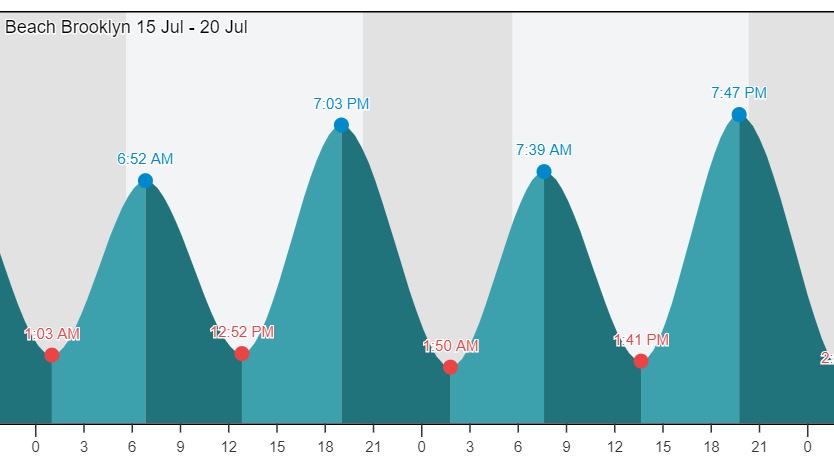
One way, from Brighton toward Coney Is:
From 730am-12pm Sat and 815am-1pm Sun there will be a solid current toward Coney Is. If you do a one way swim, the 800+m course shown below, you can get some help during these times.
(start: very small jetty directly in front of the parking lot, between the bath house and the shelter)
(finish: five jetties down, right in front of the silver aquarium building)
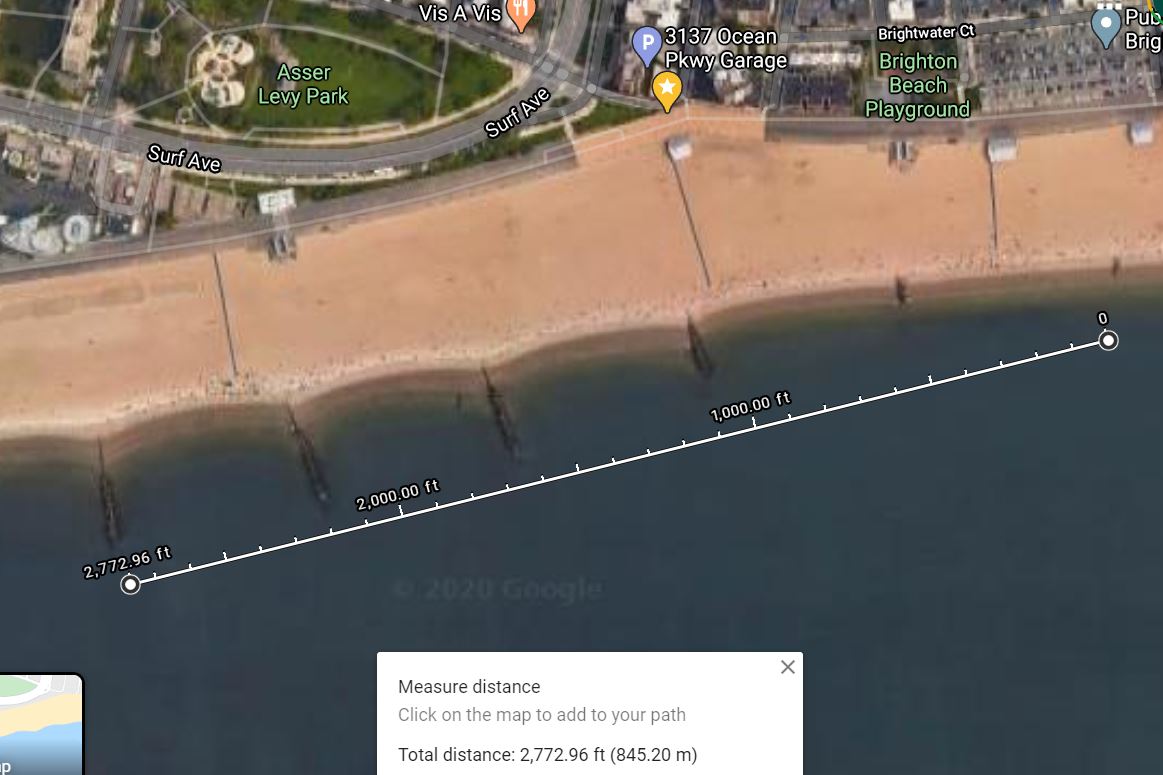
Out and back at Brighton:
There are fairly slack tides for 15min either side of the peaks and valleys shown on the chart, which are ideal for an out and back.
(start/finish: edge of bath house, in line with the blue walkway)
(turnaround: three jetties down, the first full size jetty that direction)
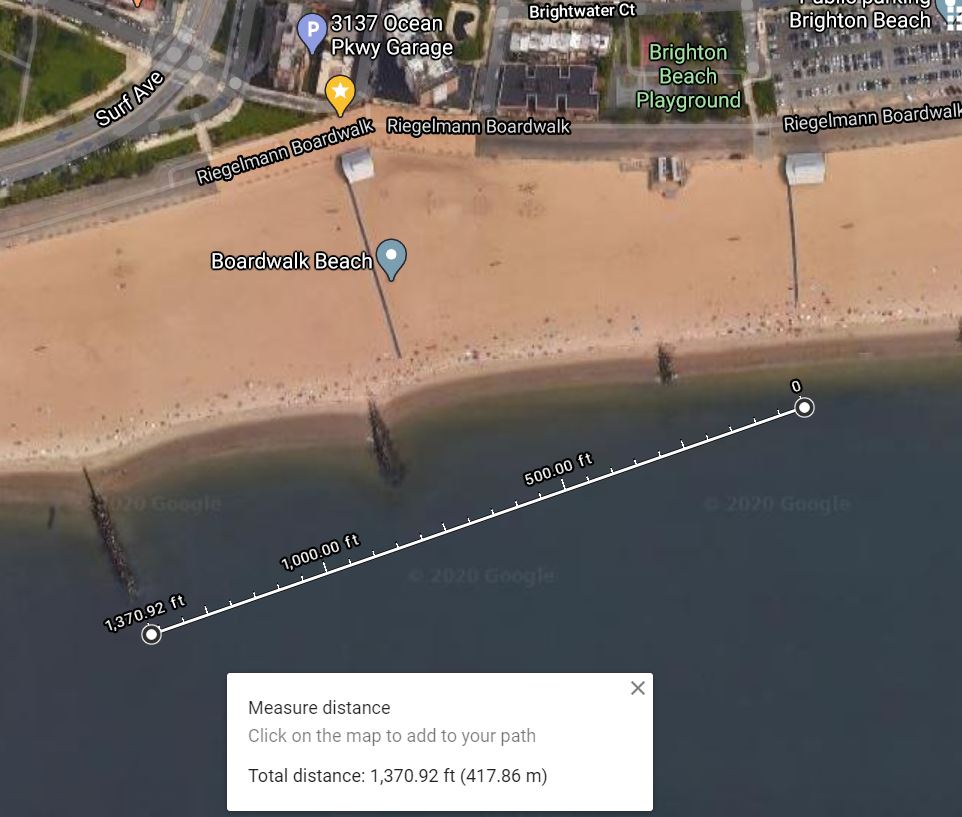
3. Bike/Run with Christine
If you are meeting Christine at 15th St on Sat morning, you’ll want to be ready for the bike/run transition. Be ready to spread out beyond the island to maintain spacing. Watch for dogs and peds since they are out in force, and be super nice when they are not looking for you or let their dogs go early before crossing the road. Wear your helmet: a guy crashed right behind me yesterday, and in getting him cleaned up we noticed his helmet really saved him. (A random stick had popped up and gotten stuck between front tire and frame.)
3a. Plan your race/Race your plan:
You’ll need to be spot on with your bike pacing and cadence, and start the first 5min of the run at or just slower than planned race pace to give yourself a shot at the best run possible. In this case your swim will, in all likelihood, be done later in the day, and you should do your entire recovery routine to be ready.
4. Have fun and be safe!
BTC Brick Workout – Week 14 – July 9, 2020
BTC Brick Workout
Week 14
7/9/20
Hi Everyone,
It’s vital to know how cycling cadence affects your run, and how run pacing impacts your ability to finish strong. This week you’ll continue to optimize both. You’ll need a cadence meter on your bike. You’ll want to try out different cycling cadence models over time to see what gives you the best run. Most people go out too fast on the run, and need to practice running specific paces out of transition. These ideas play out in the Trials below.
If you completed Trial 1 last month, you’re ready for a small, but perhaps significant change. For Trial 2 you’ll maintain intensity at the same level as Trial 1, but for the final 10min of the bike you’ll reduce cadence 20%. Recall the study noted in Week 9:
Vercruyssen and Suriano (2005) found that run time to exhaustion (at 85% of max velocity) was significantly increased (>30%) after a 30min ride (at 90% of lactate threshold) if cadence was dropped 20% from the athlete’s freely chosen cadence for the final 10min before the run.
You’ll get to see if this works well for you.
The goals of this week’s brick are:
1) Complete a cycling cadence/run pacing brick, or ‘Trial’
2) Give yourself feedback you’ll use for comparison the next time you do it
To make any test easier to learn from, it should be done under the same (or very similar) circumstances. I’m giving you a number of options that can be done repeatedly over the weeks and months. The bike portions are all steady efforts, and the sessions could fit easily into many types of training blocks or weeks. Fortunately or unfortunately, you’ll need to do the SAME ONE several times to learn what you need. It needs to FEEL the same, be the same INTENSITY, so you get a sense of whether the changes you’re making are improvements. I’ll post this type of session every five weeks, but you could also go rogue and do this three weeks in a row.
Learning fast can be fun!
The Brick Workout:
WARM-UP:
Raise your heart rate and loosen up your legs with a 10-15min easy jog, including several 30sec pickups.
MAIN SET:
Do one of the following sessions in the specified zone, with the Trial 1, 2, or 3 format (depending on where you are in the series).
Effort is maintained in the same zone for the entire brick.
(For those of you checking Training Stress Score/TSS, ‘A’ ~ 70, ‘B’ ~ 55)
ZONE 2 (Half/Full IM)
‘B’ – 40min bike/15min run
‘A’ – 60min bike/20min run
ZONE 3 (Oly/Half IM)
‘B’ – 30min bike/15min run
‘A’ – 40min bike/20min run
ZONE 4 (Sprint/Oly)
‘B’ – 20min bike/15min run
‘A’ – 30min bike/20min run (suffer a little!)
Note 1: If you don’t know your zones, plan to do a bike and/or run test in the near future, AND choose a typical moderate Prospect Park loop time you’ve been doing recently, perhaps for the Tuesday rides, and match it. Same effort level for the run.
Note 2: Your zones could change between bricks due to new tests, and that’s fine. You could be faster for a given HR, wonderful. It’s similar output – what your body feels – that matters.
Work through a series of cadence/pacing models over a couple of months, using the same brick main set. For example:
Trial 1 – Constant RPM (your choice) bike at constant output / 1K run at 15-30sec/mile (your choice) slower than goal avg pace then, for the rest of the time, build gradually to just faster than goal avg pace (this is your baseline brick)
Trial 2 – Same average RPM as Trial 1 bike, 20% lower RPM (final 10min only), all at constant output / same run as Trial 1, with updated pacing if you’ve gotten faster
Trial 3 – RPM 5-10% different from first two trials, higher or lower (but probably not below 80rpm), NO reduction the final 10min, all at constant output / 1K run at updated sec/mile slower (based on Trials 1 & 2) than goal avg pace then for the rest of the time build gradually to just faster than goal avg pace (For Sprint/Zone 4 brick, go for at least 10% higher bike cadence than usual.)
Note: Findings from these sessions will help design the race simulations discussed in the Brick Goal-Setting article, when you get closer to a goal race. As you progress, you’ll be going longer for the Half and IM distances, and will be able to check your cadence and run pacing findings under something closer to actual race fatigue.
Give yourself some feedback:
– Did I find myself having to push hard following many gear shifts, or spinning out? (You may need help with shifting)
– Did I find myself shifting a lot to maintain output, perhaps finding myself ‘between gears’ more often than I’d like? (You may need help with shifting, or a new cassette or chainring/crankset.)
– Was I not shifting much at all, and perhaps not paying close enough attention to my cadence?
– If cadence was recorded, how much did it vary, and how could I tighten the spread?
– How did my legs feel off the bike? (heavy to limber, on a scale of 1-10)
– How long did it take my legs to feel ‘normal’ off the bike? (1/4mi, 1/2mi, longer?)
– What was my run HR and/or RPE? (lower for the same pace is better)
– Was my overall run pace faster than expected, perhaps at the same or lower HR or RPE?
BTC Brick Workout – Week 13 – July 2, 2020
BTC Brick Workout
Week 13
7/2/20
Hi Everyone,
The goals of this week’s brick are:
1) Complete a brick at Olympic distance race pace
2) Confirm training zones and/or the pacing you’ve seen in training so far
3) Evaluate your bike/run transition in order to optimize it
Note 1: This is a workout to be (at least fairly well) rested for if possible. If you start the warm-up jog and your legs feel heavy, or your heart rate doesn’t want to rise, or you get to the bike and it seems like a lot of extra effort to push Z3 power/pace/HR, end the workout there and keep it to a very easy 30min jog or ride. Give it another day or two.
Note 2: You’ll have a shot at this workout every five weeks this summer. It’s ideal if you can do it on the same course each time. Or, two courses you can do a couple times each for comparison.
Note 3: You could practice some race fueling by having something midway through the bike, and at mile one of the run. It’s good to see how your body responds to planned race foods, at race pace. Try to eat a meal 2-3 hours before the workout, so your muscles will be topped off, but your stomach won’t be heavy.
The Brick Workout:
WARM-UP:
Raise your heart rate and loosen up your legs with a 10min easy jog including several 30sec pickups with 1min rest.
TRANSITION: As fast as possible
Have your swim to bike transition set up for when you come in off the warm-up jog. Your helmet is on your bike, upside down with straps placed to the outside, glasses inside, for easy access. Glasses should go on under helmet straps so they stay in place when you take the helmet off for the run. Bike shoes are either on the bike with rubber bands, or in some other way ready to be carried down those five flights of stairs in your walk-up. You’re not walking down stairs with bike shoes on…
BIKE:
Distance: 50min, or 3-5 loops of the park, depending on pace
Effort:
10min build effort, power, or heart rate to Zone 3 without overshooting.
40min between lower and upper Tempo/Zone 3, as steady as you can make it.
If you’ve been doing Coach Peter’s bike sessions, you will know this zone like your own reflection. Now’s your chance to settle in and see if what you’ve been doing, how your breathing has felt, the pacing or lap times you’ve seen, fit into Olympic distance racing. You should finish this bike ready to run. If you are breathing heavy off the bike, you’ve gone too hard, or need more weeks on the bike to build fitness at this level.
Data: Maybe your HRM/Power meter aren’t working. After cursing them, you have a realization this could happen in a race, and you still want to do the session. Get some split times. Then you can compare them to your Zone 3 work from Peter’s rides and see if pacing/lap times are similar. They should be. Use your split timer to record your time, or GPS watch to record pace, or your HRM and/or Power Meter to record heart rate or power. Note RPE if using that metric.
TRANSITION: As fast as possible
Get out of your shoes on the bike if possible, keeping your eyes on the road in front of you, and riding in with your feet on top of your shoes. Dismount into a jog in bare or socked feet if you can do this safely. Once inside it’s just popping on a run cap, donning shoes, and getting out of there.
RUN:
Distance: 25min
Effort:
5min moderate, trying to stay just under planned average race pace (Zone 3) without overshooting. Let your HR settle into the new discipline.
20min steady Zone 3 pace and/or HR
You really don’t want to go out too hard here. This is where your multi-brick pacing work pays off. Your focus should be on running tall and opening up your stride a bit. You’ll be a little stiff from the ride. At the end of 25min, you’ll be working fairly hard. The last several miles of an Olympic distance run are doable, but brutal at the same time.
Data/Learning: Perhaps pacing is on target, but HR is not what you’re used to seeing. If you feel okay, go with pacing. HR is lagging, and influenced by many variables. I had a marathon PR once with an average HR 10bpm above what I saw throughout training. It’s unnerving, but not the end of the world. Use your split timer to record your total time and/or GPS watch to record pace, or your HRM to record heart rate. Note RPE if using that metric.
Q&A
BIKE:
– Was your bike pacing correct for the distance? If not, how must it be modified to succeed next time you do this workout (5 weeks)? If your run was difficult, but you felt good getting off the bike, look closely at overall fitness, fueling/hydration in past days, or whether you still need to go a little easier on the bike.
– Is there anything off about the training zones you have set up, or do they seem spot on based on this effort?
– If riding in the park, were the lap times (minus any pedestrian slow-downs) what you are used to for this heart rate or RPE?
– Was your cadence steady throughout? Any issues shifting? Sometimes you can find yourself between gears a lot for a particular effort level, and you’ll perhaps need to make an equipment adjustment at some point.
TRANSITION:
– Was it smooth and quick with no delays?
– Did you run out with your bike helmet? Congrats! We’ve all done it.
– Any equipment changes to make, such as bike shoes or speed laces, or something else?
RUN:
– How was your pacing? If you went out too fast (or too slow – you don’t want to do 10min pace if you’re going for 8s), how will you dial it in better next time?
– Could you have kept going for another three miles at this pace or faster if personal glory was on the line?
– How long before you hit your stride and felt fully acclimated to the run?
– If you ate, how did that go?
BTC Brick Workout – Week 12 – June 25, 2020
BTC Brick Workout
Week 12
6/25/20
This is our Week 7 video. Just be aware that this week’s session has fewer transitions. Please see the Week 7 post for an example worksheet to track your data (if not using something electronic).
Hi Everyone,
The goals of this week’s brick are:
1) Multi-brick with negative splits
2) Focus on the distances you’ll complete for a Sprint Tri, with lightning-fast transitions (amazingly similar to the BTC Virtual Tri coming up later in July!)
3) Review Training Zones and their respective Adaptations
The Brick Workout:
OPTIONS:
- Easy: keep it in Zone 1 for a recovery session
- Mod: drop all the zones one level, so you start with Z2 on the bike
- Hard: as written
WARM-UP: Run 1 mile easy, with a few 30sec pickups to a moderate effort.
TRANSITION: As fast as possible to the bike.
ROUND 1
BIKE:
Distance: Ride two loops of the park
Effort: Build to lower Zone 3 (effort 4/10) over their first several minutes, then very gradually build to upper Zone 3 (effort 6/10) by the end of the second loop.
TRANSITION: As fast as possible
Get out of your shoes on the bike if it’s possible to do so safely, keeping your eyes on the road in front of you, and riding in with your feet on top of your shoes.
RUN:
Distance: Run 1.5 miles
Effort: Maintain pace/HR in mid-Zone 3 (effort 5/10)
ROUND 2
BIKE:
Distance: Ride two loops of the park
Effort: Build to lower Zone 4 (effort 7/10) over their first several minutes, then very gradually build to upper Zone 4 (effort 8/10) by the end of the second loop.
TRANSITION: As fast as possible
RUN:
Distance: Run 1.5 miles
Effort: Build from Zone 4 (effort 7/10) to Zone 5 (effort 9/10), with a strong finish.
Preparation:
– Set up your bike pedals using rubber bands (as if you were going to run it out of transition and do a step on or flying mount). You’ll do this to start your first bike if you’re using a trainer, and if you are comfortable, on the road. You can do a normal stepover mount, but it’s good to practice setting up your pedals. You could do it each time you start a new bike leg, but it’s not required.
– Get your electronics set up and on your body and bike: sports watch, Heart Rate Monitor (HRM), Power Meter, etc.
– Before the workout, try to get them connected online and get somewhat comfortable with the screens and data you’re seeing. You’ll upload data afterward, or your device may do this for you automatically.
Training Zones:
Here’s a review of our Training Zones, including the Borg Scale for Rate of Perceived Exertion. We want to be thinking in these terms within most of our workouts.



